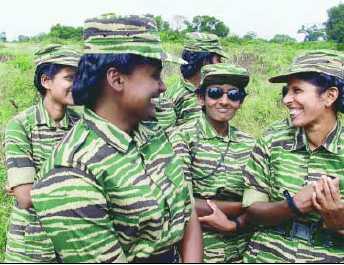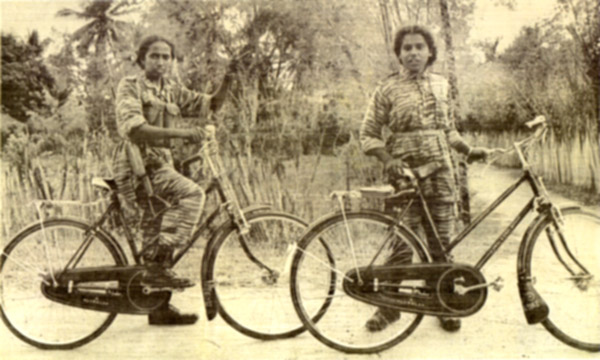 As a national liberation movement the LTTE has a women guerrilla wing which has been actively involved in the political and the military struggle and has made remarkable achievements in the awakening of women's revolutionary consciousness. Though the armed resistance campaign of the Liberation Tigers has a history extended to seventeen years, the women's military structure has a six year old history. The conservative nature of our social formation, its oppressive structures against women, its g e n d e r discrimination, have contributed to the delayed development of women's participatory role in the armed struggle.
As a national liberation movement the LTTE has a women guerrilla wing which has been actively involved in the political and the military struggle and has made remarkable achievements in the awakening of women's revolutionary consciousness. Though the armed resistance campaign of the Liberation Tigers has a history extended to seventeen years, the women's military structure has a six year old history. The conservative nature of our social formation, its oppressive structures against women, its g e n d e r discrimination, have contributed to the delayed development of women's participatory role in the armed struggle.
The racial holocaust of July 1983 and the genocidal repression of the state that followed awoke the Tamil national consciousness. Outraged by the pogrom, the entire nation was stirred to resist the mounting Sinhala oppression. This revolutionary awakening had its impact on the Tamil women. It was during this turbulent time, young radical women came forward to participate in the armed struggle for national liberation.
In August 1983, the LTTE formed the women wing and began to recruit female cadres. A theoretical document entitled Women and the Revolution was published in English and Tamil outlining the role and function of women in the Tamil Eelam national liberation struggle. At the initial stages our women cadres were mainly involved in the task of political propaganda. But it was in mid 1984 that women cadres were militarily trained and a well organised women guerrilla unit was established.
Thus, a women fighting force emerged under the leadership of the LTTE, for the first time in the history of the Tamil national struggle ushering in a new era of women's participation in the war of liberation.
The armed cadres of our women wing were also involved in the task of politicization and mobilisation of Tamil Eelam women, campaigning against social discrimination and national oppression and emphasising the need for women's emancipation. Towards this objective, a radical women's journal called 'Sunthanthira Paraivagal' was launched in December 1984.

From early 1985 the LTTE's women wing has been expanding its political structures in the Jaffna peninsula which was under the administrative control of the LTTE. Our women unit co-ordinated and worked with p o p u 1 a r women organisations, trade unions, industrial training centres, health and welfare associations, educational institutes and was campaigning and organising women for the national struggle.
In the meantime, our women guerrilla units directly participated in armed combat against the Sri Lankan armed forces in the Vanni and Mannar districts. The first major battle in which our women fighters participated took place in Mannar under the command of Lt. Colonel Victor who was martyred in the fighting.
Our women guerrillas also participated in several armed confrontations in the Killinochchi and Jaffna districts to bring these areas under the control of the LTTE.
In Jaffna, our women freedom fighters participated in several successful operations launched against Sri Lankan military targets. Significant among them are the attacks on the Jaffna tele-com army camp, the commando raids on Mayiliyathani and Kankesanthurai camps under the command of Lt. Col. Ratha and the attacks on the Kurumbaciddy and Nelliyadi army camps. Our women cadres also manned several check points and defence bunkers around Sri Lankan army camps in the peninsula and faced regular shelling with tremendous courage.
By directly participating in the armed struggle, our women guerrillas have demonstrated their courage, commitment and dedication and have proved beyond doubt that they are capable of sacrificing their lives for the cause of our people. By their supreme sacrifices they have inspired the female nation and paved the way for greater participation of women in the national struggle.
Soon after the Indo-Lanka Accord was signed, the LTTE launched a massive popular campaign to expose the sinister intentions behind India's military intervention. In the protest meetings, in the demonstrations, in the boycotts in all forms of mass agitations organised by the LTTE it was women who participated in large numbers in national politics.
Thileepan's fast unto death campaign pinnacled the Tamil national protest against India. During the fast our women cadres organised and mobilised the popular masses to rally around Thileepan's cause. Hundreds of thousands of women took to the streets in mass demonstrations and public protests and Thileepan's fast and his martyrdom became a symbol of national struggle.
When the war broke out between the Indian army and the LTTE, our women guerrilla units actively participated in the armed conflict and stood shoulder to shoulder with the men fighters in that historical resistance. In the battle of Jaffna, our women guerrilla units fought ferociously and slowed down the pace of the advancing Indian columns. At the battle of Sithankerni our female freedom fighters confronted a contingent of Indian troops and in the fierce fighting that ensued an Indian tank was destroyed and several jawans were killed.
In the Indo-LTTE war which lasted for more than two years, the role and function of the women combatants has been crucial. Not only did they fight heroically against the Indian occupation forces, but they also involved themselves in non-combatant activities i.e. medical care, food supplies, transportation of arms and ammunitions etc., which helped the war effort. In the Indo-LTTE war twenty six of our women freedom fighters have attained martyrdom.
The women wing of our liberation movement has contributed substantially to advance the legitimate struggle of our oppressed people. The courage, determination and commitment of our women fighters have awakened the patriotic spirit of the female masses and has mobilised them towards the cause of national liberation.